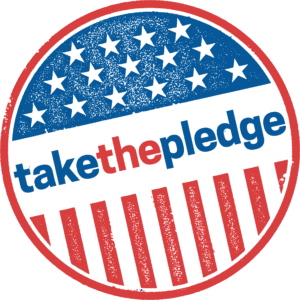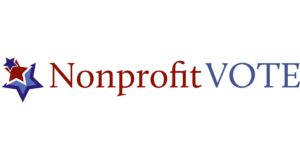
The following is a guest blog authored by Caitlin Donnelly of Nonprofit VOTE, a Nonprofit Voter Empowerment Project Co–Founder.
Have you ever brought home a new electronic – whether an upgraded smartphone or a sweet new TV – ripped open the box, and started playing around with features, forgoing the instruction manual after page 4? Then, six months later, a tech-savvy family member asks you to pull up a feature that you aren’t familiar with… your TV has voice control? Years ago, this is how I learned from an eleven-year-old that my phone could take slow-motion videos. I realized that there was a lot of functionality that I wasn’t taking advantage of because I threw that instruction manual aside. 
There is a similar dynamic going on with voter engagement at nonprofits. Leaders at many 501(c)(3) organizations are unaware that most voter registration and education activities are permissible under IRS regulations, so long as they are nonpartisan in nature. Or, they may be aware that their organization could engage voters, but they think the nonpartisanship rules are too complex. Not so! Enter your new, nonpartisanship-savvy friends, here to unlock and demystify your organization’s voter engagement features.
Nonprofit VOTE was founded in 2005 to leverage the untapped potential of the nonprofit sector to expand the electorate, educate voters, and reduce gaps in participation. Our vast library of nonpartisan voter engagement materials help nonprofits facilitate conversations about voting with staff, clients, and the community, and ensure your voters have the information they need to cast their ballot.
How Can You Engage Voters While Staying Nonpartisan?
All 501(c)(3) organizations are required to remain nonpartisan. In this context, your organization’s activities and messages must not indicate support or opposition to a candidate for office or political party. Donating to a candidate or campaign? Partisan. Suggesting which party someone should affiliate with on their voter registration form? Partisan. Re-sharing social media posts from a candidate whose platform is aligned with your mission? Again, partisan. To be clear, there are ways to engage candidates in a nonpartisan manner, including candidate forums, voter guides, and sharing your organization’s policy goals.
However, there are even more nonpartisan ways to engage voters that don’t involve talking to or about candidates at all. The activities that we find particularly effective, and good starting points for nonprofits that want to help foster a more inclusive democracy, include registering voters, encouraging staff to vote, and voter education.
In every state except North Dakota, a voter must be registered with the state or county elections department in order to cast a ballot, and most states do not allow voters to register at the same time that they vote. Any voter who has moved, changed their name, or gone several elections without voting should check and update their registration to avoid problems at the polls. Promoting or offering voter registration is a great first step for helping people to vote, so consider signing up for National Voter Registration Day, a civic holiday supported by the National Association of Secretaries of State and the National Association of State Election Directors.
The staff at your organization shouldn’t be overlooked in your voter engagement efforts. Remind them about upcoming elections and deadlines. Join nonprofits across the country in giving your staff paid time off to vote or volunteer as a poll worker. In many states, PTO for voting is required, but expanding and highlighting your policy is a great way to demonstrate your commitment to civic participation.
Information about the voting process, such as how to find your polling place, apply to vote by mail, or when early voting takes place, helps voters turn intention into action. Send and share helpful links from your state’s election website in your regular communications with staff and clients and on your social media channels.
What to Tell Your Staff About Being Nonpartisan
All nonprofit staff should have some guidance around nonpartisanship. While representing the organization, staff (and volunteers) should remain neutral if they are asked about candidates and parties, and they treat all clients and voters equally regardless of their political affiliations. At the same time, nonprofit staff have a life outside of the organization, and are entitled to support candidates for office, volunteer for campaigns, and even run for office themselves, so long as they do so only during their personal time, refrain from using equipment or resources from their nonprofit, and avoid affiliations with the organization (such as wearing a shirt from your organization’s event while canvassing for a candidate or identifying themselves with your organization when signing on to letters of support, donating, etc.)
For staff that are involved in communications, advocacy, or external relations, provide additional training or resources on nonpartisanship so they can navigate questions about politics confidently. The resources and technical assistance offered by Bolder Advocacy provide clear and trusted information.
It’s Time for a Feature Update
Don’t wait for your eleven-year-old nephew to show you how to use that remote. Learn the rules and take advantage of your organization’s natural assets – trust and good will among communities served, along with daily connections with staff, clients, and members – to provide timely reminders and information about voting. Once engaged, the communities we serve will step into their power to influence decision makers and our organizations will be better positioned to drive policy decisions and, ultimately, achieve our missions.
The Nonprofit Voter Empowerment Project is a nonpartisan pledge campaign that was developed by Independent Sector in partnership with Nonprofit VOTE to support nonprofits as they work to increase voter participation among their staff, grantees, volunteers, and constituents in 2022 and beyond.




